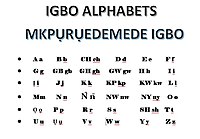The modern Igbo alphabet (Igbo: Mkpụrụ Edemede Igbo), otherwise known as the Igbo alphabet (Mkpụrụ Edemede Igbo[1]), is the alphabet of the Igbo language, it is one of the three national languages of Nigeria.[2] The modern Igbo alphabet is made up of 36 letters,[3] which includes only a 23-letter set of the ISO basic Latin alphabet minus Q and X, which are not part of Abidịị Igbo. C is not used other than in the digraph 'ch' and proper names. The alphabet uses the dot above on the letter Ṅ, and the dot below on Ị, Ọ and Ụ.
| Mkpụrụ Edemede Igbo Ásụ̀sụ́ Ìgbò | |
|---|---|
 Niger-Congo, Atlantic-Congo, Volta-Congo, Volta-Niger, Igboid | |
| Languages | |
| ISO 15924 | |
| ISO 15924 | Latn (215), Latin |
| Unicode | |
Unicode alias | Latin |
There are numerous Igbo dialects, some of which are not mutually intelligible. The standard written form of Igbo is based on the Owerri and Umuahia dialects of Igbo.
A New Standard Orthography has been proposed for Igbo, and it was used, for example, in the 1998 Igbo English Dictionary by Michael Echeruo, but it has not been otherwise widely adopted. In this orthography, diaeresis replaces the dot below (ï ö ü), and the ch digraph is not used.
Letters
editThe 36-letter alphabet is called Mkpụrụ Edemede or Abidịị, featuring 28 consonants (mgbochiume) [clarification needed]and 8 vowels[4] (ụdaume).
Aa IPA: a
|
Bb IPA: b
|
CHch IPA: t͡ʃ
|
Dd IPA: d
|
Ee IPA: e
|
Ff IPA: f
|
Gg IPA: g
|
GBgb IPA: ɡ͡ɓ~ɓ
|
GHgh IPA: ɣ
|
GWgw IPA: ɡʷ
|
Hh IPA: ɦ
|
Ii IPA: i
|
Ịị IPA: ɪ̙
|
Jj IPA: d͡ʒ
|
Kk IPA: k
|
KPkp IPA: k͡p~ɓ̥
|
KWkw IPA: kʷ
|
Ll IPA: l
|
Mm IPA: m
|
Nn IPA: n
|
Ṅṅ IPA: ŋ
|
NWnw IPA: ŋʷ
|
NYny IPA: ɲ
|
Oo IPA: o
|
Ọọ IPA: ɔ̙
|
Pp IPA: p
|
Rr IPA: ɹ~ɾ
|
Ss IPA: s
|
SHsh IPA: ʃ
|
Tt IPA: t
|
Uu IPA: u
|
Ụụ IPA: ʊ̙
|
Vv IPA: v
|
Ww IPA: w
|
Yy IPA: j
|
Zz IPA: z
|
See also
editReferences
edit- ^ ezinaulo. "Igbo Alphabet". Ezinaulo.
- ^ "Discover the fascinating history, language and culture of Nigeria". World Travel Guide. Retrieved 2020-04-06.
- ^ Nkamigbo, Linda Chinelo (2011-10-14). "Phonology in Teacher Education in Nigeria: The Igbo Language Example". African Journal of Teacher Education. 1 (1). doi:10.21083/ajote.v1i1.1593. ISSN 1916-7822.
- ^ Agbo, Maduabuchi Sennen (2013-09-30). "The Morphosyntactic Coding of Focus Structure in Igbo". Journal of Universal Language. 14 (2): 53–78. doi:10.22425/jul.2013.14.2.53. ISSN 1598-6381.
External links
edit- https://www.omniglot.com/writing/igbo.htm
- https://ezinaulo.com/igbo-lessons/pronunciation/igbo-alphabet/
- https://www.britannica.com/topic/Igbo
- Igbo language Orthography and spelling
- "The Official Igbo Orthography as recommended by the Onwu Committee in 1961 Notes on script and spelling for teachers" (PDF).
